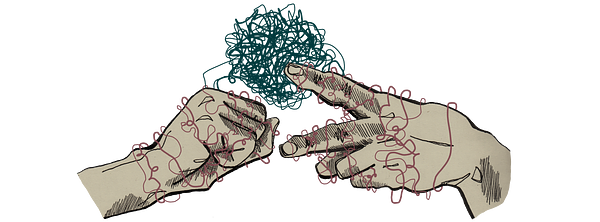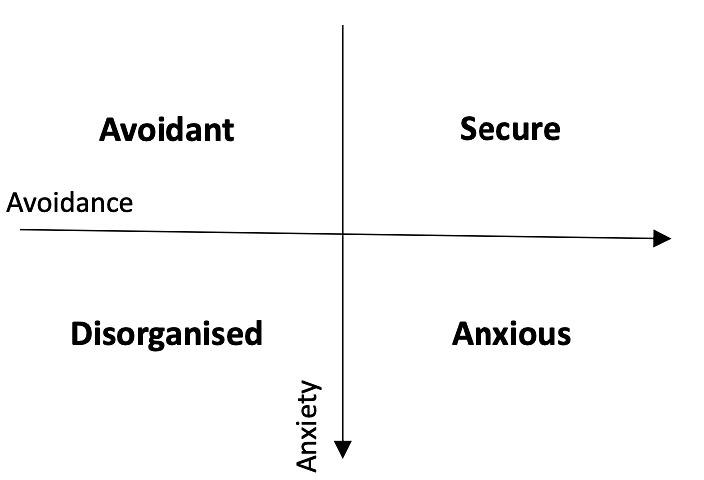Professionals and Practitioners
This digital resource tells the story of how our brains interpret the world around us and how this translates in our bodies, emotions and behaviours. It has been designed to be used by professionals working with young people interested in learning more about the science of conflict and boosting their wellbeing.

Different Attachment Styles
Summary
- Based on experiences we had in infancy, we all have ‘attachment styles’ that influence how we relate to others.
- There are four main attachment styles: Secure, Anxious, Avoidant, Disorganised. People rarely have one style of attachment; over time, we experience a mixture or different intensities of attachment style.
Because parents behave in different ways towards their babies, children will respond by developing different types of ‘attachment style’.
Attachment styles remain with us throughout our lives, and influence the way we relate to other people and with ourselves, as well as how we express our feelings.
Each style is related to a particular manner of parenting and quality of early relationships in infancy. There are four main attachment styles:
- Secure
- Anxious
- Avoidant
- Disorganised
People rarely exist in a state of being exactly one or another different style of attachment. Instead, imagine that attachment style exists on a spectrum, with people experiencing a mixture or different intensities of attachment style.

Let’s look at each of these styles in more detail.
Secure Attachment
People who possess a secure attachment style enjoy connecting with other people in an open and self-assured way. They can express a need for love and affection, and have relationships in which they feel valued and supported. People with a secure attachment trust that people will not abandon or mistreat them; they consider themselves worthy of loving relationships and will not long suffer relationships which lack mutual respect. They are comfortable in offering care and support to others.
People who experience a secure attachment style had a close bond with a primary caregiver in early life. As a baby, they had at least one adult who was paying attention and responding to their emotional and physical needs. This could include feeding the baby when it is hungry, smiling at each other whilst playing, or offering loving physical comfort when upset. Whilst securely attached babies display distress when separated from their attachment figure, they are quickly able to calm down and relax once reunited with them. They can confidently enjoy exploring their surroundings, without feeling anxious that their loved ones will abandon them. They are cautious of strangers, but will relax if the new person shows warmth and signs that they can be trusted.
Based on experiences we had in infancy, we all have ‘attachment styles’ that influence how we relate to others.
Anxious Attachment
People who have an anxious attachment style fear other people will abandon them and that their needs for emotional and social connection won’t be met.
They often feel anxious in romantic relationships, and may feel frequently overwhelmed by difficult feelings, as they struggle to regulate their emotions in stressful situations.
People with an anxious attachment style may interpret ambiguous situations as negative, due to early experiences of people being unreliable. For example, an anxiously attached person may believe that because their partner didn’t respond enthusiastically and immediately towards a suggestion that they must hate it and maybe him or her too, when in fact they are disposed to agree, they’re just taking a moment to think about it or are tired. The anxiously attached person will become emotionally distressed and may display ‘protest behaviours’ such as shouting, throwing things, or giving their partner the ‘silent treatment’.
As infants, people with an anxious attachment style had caregivers who were not able to consistently and reliably give them attention and meet their emotional and physical needs. It may be that parents were struggling with mental health or relationship difficulties of their own, and were subsequently unable to be fully present to provide consistent loving care to their baby. These infants therefore grow to doubt whether other people will be able to look after them and stay with them. They often believe that they are to blame for not being reliably cared for as an infant, and view themselves as unlovable, even though this is untrue.
Avoidant Attachment
People with an avoidant attachment style often struggle to display vulnerability and establish close social connections. They often detach from their emotional experience and prefer to keep people ‘at arm’s length’ rather than seek out meaningful relationships.
They may appear aloof and unfeeling to other people. However, deep down they have an unmet need for love and closeness, but they do not believe that other people are capable of satisfying this need, so they prefer to remain distant from others to avoid the pain of expected disappointment or rejection.
During infancy, people with an avoidant attachment style typically had parents who were consistently unable to meet their needs for attention and care. Their parents may have felt too overwhelmed by their own difficulties and ignored their baby’s cries for attention. Over time, these babies grow to believe that they are unlovable and that people will always let them down, so it is best not to depend upon others for closeness, affection or care.
To cope with the pain of having consistently unmet needs as babies, people with an avoidant attachment style have learned to disconnect from their inner world, and thus have a harder time knowing and expressing their thoughts and feelings.
Disorganised Attachment
People with a disorganised attachment style experience a mixture of anxious and avoidant attachment style tendencies. People with disorganised attachment may appear confusing to other people, as their behaviour seemingly randomly changes from anxious and emotionally explosive, to withdrawn and emotionally shutdown.
This attachment style is least common and typically a result of childhood abuse and neglect.
As babies, people with a disorganised attachment style had parents who were frightening and unreliable carers. Disorganised attached infants are forced to depend upon an adult who is also a cause of fear and harm.
To cope with this, they display both avoidant ways of managing distress, as well as anxious strategies to gain attention and affection. They also experience dissociative symptoms like physically freezing or psychologically detaching from reality in response to stress. These reactions enabled the person to survive their abusive or neglectful childhoods. However, as adults, this attachment style keeps them from feeling safe and calm in relationships and may also prompt them to seek out social connections which are exploitative or otherwise harmful, as this feels familiar to them.
References and Further Reading
- The Trait That ‘Super Friends’ Have in Common by Marisa G. Franco. Atlantic, 2022.
- Attachment Styles and their Role in Relationships. The Attachment Project, 2023.
- What Attachment Styles Can – and – Can’t Explain by Allie Volpe. Vox, 2023.
- Infant-parent attachment: Definition, types, antecedents, measurement and outcome by Diane Benoit. National Library of Medicine, 2004.





